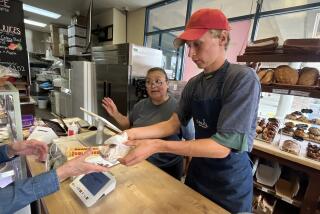Two Temblors Near Chatsworth Rattle More Nerves Than Homes
- Share via
The strongest aftershock this year of the 1994 Northridge quake, a 3.9, rattled built-up areas of the northwest San Fernando Valley at 11:51 a.m. Wednesday.
Caltech seismologists said the epicenter of the quake--and that of a magnitude 3.1 foreshock 22 seconds earlier--was two miles north-northeast of Chatsworth at a depth of 3.5 miles.
The quake was felt lightly through much of the Valley and weakly in Santa Monica and northward along the coast. No damage or injuries were reported, although a quake of such magnitude in a built-up area normally would cause some minor breakage.
It was more like a major headache to Joan Langer of Northridge, who returned home from a morning arts class to find broken glass scattered across the dining room floor of her neatly kept home.
Two glass shelves in the family’s china cabinet had collapsed, loosing a cascade of fragile collectibles and a flood of bad memories.
“Last time, we lost all of the crystal we brought from Ireland,” said Langer, recalling the extensive damage her home sustained in the ’94 shaker. “Two Lladro statuettes that they didn’t get last time, they got this time.
“I guess some people just aren’t meant to have glass.”
Elsewhere in the Chatsworth-Northridge area, residents and merchants reported that the twin temblors rattled more nerves than pottery.
“When the Northridge quake happened, everything was on the floor completely,” said Dana DelBoccio, manager of the Aaron Brothers Art Marts store on Reseda Boulevard, which suffered no damage Wednesday.
“We’re just not looking forward to another one.”
There have been about 14,700 Northridge quake aftershocks, including 63 larger than the strongest one Wednesday, according to Caltech seismologist Kate Hutton.
But, with aftershocks occurring less frequently, Wednesday’s was the largest since a spasm of jolts reaching magnitude 5.0 hit an area between the Simi and Santa Clarita valleys last year on April 26 and 27.
Aftershocks do not diminish over time at a steady rate. There are typically spurts of activity, although fewer and fewer until they end years after the initial quake.
Wednesday’s strongest shake was about twice as powerful as a 3.7 aftershock felt on May 1. That quake was centered in a mountainous area northeast of Simi Valley, so it was not noticed nearly as much.
Although more than four years have passed since the magnitude 6.7 Northridge disaster of Jan. 17, 1994, Hutton said it is not at all surprising that a 3.9 aftershock would occur now.
Dave Wald, a seismologist with the U.S. Geological Survey who maps the shaking intensities of Southern California quakes, said Wednesday’s quake had, at the Northridge seismographic measuring station, only about 3% of the force of gravity.
By comparison, the main Northridge quake had an intensity of about 100% of gravity through much of the Valley, and reached a measured peak of 170% in Tarzana.
Wald said the latest aftershock lasted only a fraction of a second, although the reverberations may have been felt for several seconds.
(BEGIN TEXT OF INFOBOX / INFOGRAPHIC)
Twin Shakers
Two temblors, 22 seconds apart, jolted the Valley on Wednesday. Epicenter of the first was under a Chatsworth cul-de-sac. The second hit 3/4 of a mile to the north, in an undeveloped area.
*
11:51:32 a.m.-3.9 magnitude
11:51:10 a.m.-3.1 magnitude
More to Read
Sign up for Essential California
The most important California stories and recommendations in your inbox every morning.
You may occasionally receive promotional content from the Los Angeles Times.













